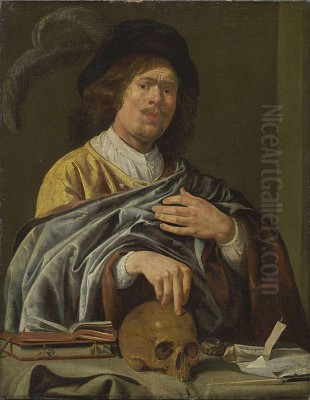
Jan Miense Molenaer (c. 1610–1668) stands as a significant and engaging figure in the rich tapestry of Dutch Golden Age painting. Active primarily in Haarlem, a vibrant artistic hub during the 17th century, Molenaer carved a niche for himself as a versatile painter of genre scenes, portraits, and occasionally, religious and allegorical subjects. His work provides a lively window into the daily lives, festivities, and social customs of the Dutch Republic, often infused with a characteristic blend of humor, keen observation, and subtle moral commentary. He shared his life and, for a time, his studio with the equally talented painter Judith Leyster, forming one of the most notable artistic couples of the era.
Early Life and Artistic Formation in Haarlem
Born in Haarlem around 1610, Jan Miense Molenaer grew up in a city brimming with artistic activity. Haarlem was home to renowned masters and a thriving art market, providing fertile ground for aspiring painters. While definitive documentation is scarce, it is widely accepted by art historians that Molenaer received his formative training in the bustling studio of Frans Hals, the preeminent portraitist and genre painter of Haarlem. The stylistic connection between Molenaer's early works and Hals's dynamic approach strongly supports this association.
During this period, likely in the late 1620s, he would have absorbed Hals's techniques: the loose, energetic brushwork, the ability to capture fleeting expressions, and a penchant for depicting scenes of merriment and everyday life. It was also likely in or around Hals's circle that he met Judith Leyster, another gifted artist who is believed to have studied or worked with Hals. This early training laid the foundation for Molenaer's career, equipping him with the technical skills and thematic interests that would define his oeuvre.
The Influence of Frans Hals and Haarlem Circles
The impact of Frans Hals on Jan Miense Molenaer's early artistic output is undeniable. Works from the late 1620s and early 1630s clearly echo Hals's style. Molenaer adopted a similarly vigorous brushstroke and a relatively bright palette to depict lively scenes, often featuring peasants carousing in taverns or families engaged in music-making. He captured the boisterous energy of these gatherings, focusing on expressive faces and dynamic compositions.
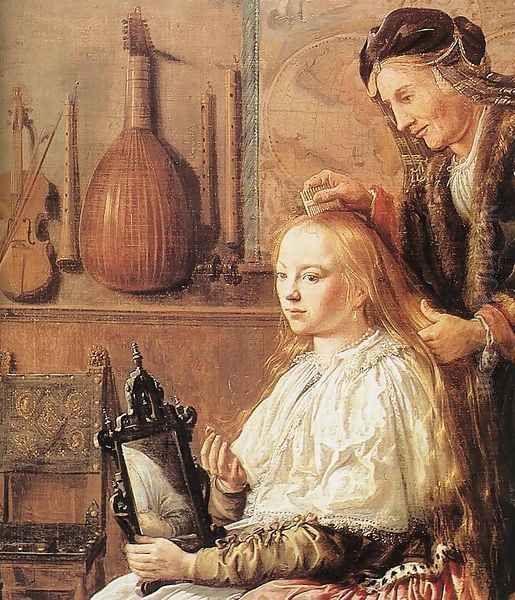
Beyond Frans Hals, Molenaer was also likely influenced by other artists active in Haarlem. Frans Hals's younger brother, Dirck Hals, specialized in "merry company" scenes – elegant gatherings often featuring music and conversation. Molenaer's depictions of interior scenes with multiple figures sometimes show an affinity with Dirck Hals's compositions and subject matter. Furthermore, the raw, often humorous, and less idealized depictions of peasant life by Adriaen Brouwer, who worked in Haarlem for a period, may also have resonated with Molenaer's interest in genre subjects, although Molenaer's touch was generally lighter and less coarse than Brouwer's.
Marriage and Artistic Partnership with Judith Leyster
In 1636, Jan Miense Molenaer married Judith Leyster (1609–1660). Leyster was already an accomplished and recognized painter in her own right, having been admitted to the Haarlem Guild of St. Luke in 1633. She was one of the few professional female artists of the period to achieve significant success. Following their marriage, the couple initially lived and worked in Amsterdam before returning to the Haarlem area (specifically Heemstede) later in their lives.
They operated a joint studio, and their artistic styles inevitably influenced each other, particularly during the early years of their marriage. Both shared an interest in genre scenes, music-making figures, and domestic interiors. Distinguishing their hands during this period can sometimes be challenging for art historians, leading to past misattributions. For many years, Leyster's work was often subsumed under her husband's name or even attributed to Frans Hals. It was only in the late 19th century that dedicated research began to re-establish her distinct artistic identity and significant contributions.
While they collaborated and shared thematic interests, Leyster developed her own distinct style, often characterized by more intimate scenes, sensitive lighting, and a focus on female subjects or quiet domesticity, contrasting with some of Molenaer's more boisterous tavern scenes. The demands of raising a family (they had several children) may have impacted the volume of Leyster's later output compared to her husband's, a common challenge for female artists of the time. Their partnership remains a fascinating example of artistic synergy and the complexities of gender roles within the 17th-century art world. It is important to note that Molenaer's wife was Judith Leyster, not Magdalena van de Passe, who was a contemporary engraver from a different artistic family.
Evolution of Artistic Style
Molenaer's artistic style was not static; it evolved considerably throughout his career. His early works, heavily indebted to Frans Hals, are characterized by their vivacity, relatively bright colors, and visible, energetic brushwork. Figures are often animated, caught mid-gesture or mid-laugh, contributing to a sense of immediacy and spontaneity. Paintings like The Dentist (c. 1630) exemplify this early phase.
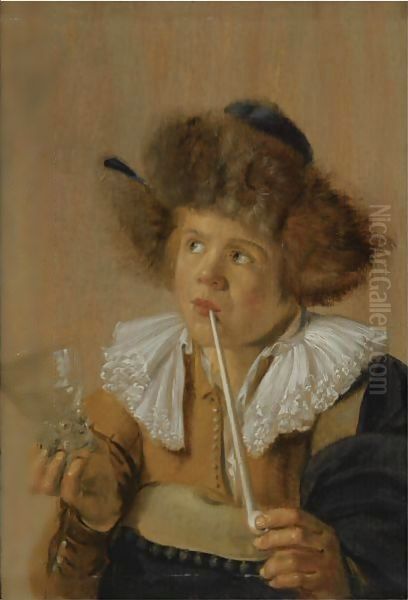
From the mid-1630s onwards, Molenaer's style began to shift. His brushwork became tighter and more controlled, and his palette often grew more subdued and tonal, favouring browns, greys, and ochres, sometimes punctuated by touches of stronger color. This move towards greater refinement and detail might reflect the influence of Leiden 'fijnschilders' (fine painters) like Gerard Dou, or perhaps a response to changing market tastes.
In his later works, Molenaer often demonstrated a greater interest in narrative detail and complex compositions. Some art historians see parallels with the work of Jan Steen, another master of Dutch genre painting known for his humorous and often moralizing scenes filled with anecdotal detail. Molenaer's figures became somewhat more doll-like or stylized in his later period, and his compositions sometimes incorporated more intricate spatial arrangements. This stylistic development showcases his adaptability and engagement with broader trends in Dutch painting.
Themes and Subjects: A Mirror to Society
Jan Miense Molenaer's subject matter was diverse, but he is best known for his genre paintings, which vividly depict scenes of everyday life in the Dutch Republic. These works offer valuable insights into the social customs, leisure activities, and domestic environments of the 17th century.
Tavern scenes and peasant gatherings were frequent subjects, especially early in his career. These paintings often depict drinking, smoking, card games, and music-making with boisterous energy. While sometimes humorous, they could also carry moralizing undertones about the dangers of excess, in line with contemporary Calvinist values.
Music-making is a recurring theme throughout Molenaer's oeuvre. He painted numerous scenes of individuals playing instruments like the lute, violin, or virginal, as well as families and groups engaged in musical performance. These works, such as Family Making Music or The Duet, often symbolize harmony, whether domestic, social, or romantic. Music was an important part of Dutch social life, and Molenaer captured its prevalence with charm and skill.
Children and their games also feature prominently in his work. Molenaer depicted children playing games like 'La main chaude' (Hot Cockles), spinning tops, or interacting with pets. These scenes are often imbued with a sense of playful innocence but can sometimes contain allegorical meanings related to learning, folly, or the stages of life. His painting Two Boys Playing with a Cat is a typical example, combining charm with a hint of mischief.
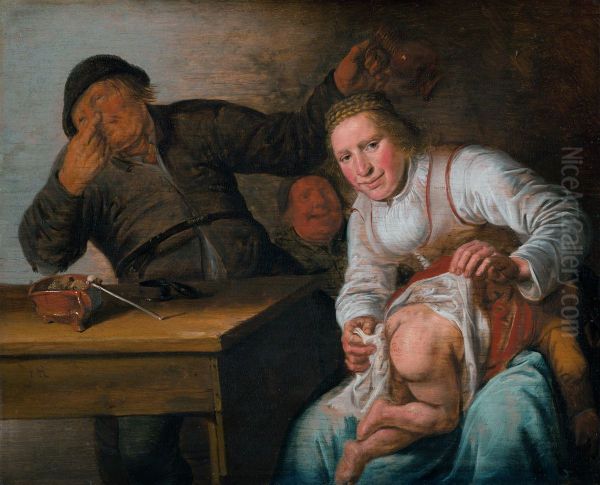
Beyond genre scenes, Molenaer also painted portraits, often depicting families within domestic settings, blending portraiture with genre elements. He occasionally tackled religious subjects, such as The Denial of Peter, bringing his genre painter's eye for human interaction and setting to biblical narratives. Allegorical works, like the Allegory of Vanity, used symbolic objects and figures to convey moral messages about the transience of life and the folly of worldly pursuits.
Notable Works
Several paintings stand out as representative of Jan Miense Molenaer's skill and thematic range:
_Allegory of Vanity_ (1633): An early work that showcases his ability to blend genre elements with symbolic meaning. It typically depicts figures surrounded by objects representing worldly pleasures and the fleeting nature of life, such as musical instruments, jewels, skulls, and hourglasses. This painting is a fine example of the Vanitas tradition popular in the Netherlands.
_The Five Senses_ Series (c. 1637): Molenaer painted a series allegorically representing the five senses (Sight, Hearing, Smell, Taste, Touch), often using figures engaged in activities related to each sense within domestic or tavern settings. Several paintings from this series survive, including Taste, Smell, Hearing, and Touch, housed in various collections like the Mauritshuis (previously) and the Phoenix Art Museum. These works demonstrate his skill in detailed rendering and allegorical representation.
_The Duet_ (c. 1629): Housed in the Seattle Art Museum, this painting likely depicts Molenaer himself and Judith Leyster playing music together shortly after they met. It's an engaging image that speaks to their personal and artistic relationship, rendered in his early, Hals-influenced style.
_Family Making Music_: Located in the Frans Hals Museum in Haarlem, this work portrays a well-to-do family gathered in a domestic interior, playing various instruments. It exemplifies Molenaer's interest in music as a theme symbolizing familial harmony and social status.
_The Music Makers_: In the collection of the Museum of Fine Arts, Budapest, this painting is another vibrant depiction of informal musical performance, showcasing Molenaer's ability to capture lively interaction and varied textures.
_Peasants at the Tavern_: Housed in the Uffizi Gallery, Florence, this work represents his engagement with peasant genre scenes, depicting figures drinking and socializing in a rustic setting, characteristic of his earlier, more boisterous style.
_La main chaude_ (Hot Cockles): This painting, depicting a popular children's game, showcases Molenaer's interest in the world of childhood and games. It captures the energy and playful nature of the subject.
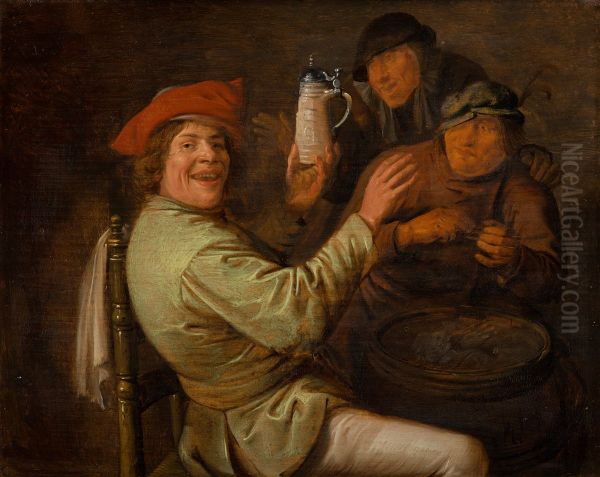
_The Denial of Peter_: Also in Budapest, this work demonstrates Molenaer's handling of religious themes. He sets the biblical scene in a contemporary Dutch guardroom or tavern environment, making the story relatable to his audience through familiar details.
_The Pig Slaughter_: A less common but telling theme in Dutch art, depicting a rural scene of a pig being butchered. Such works often carried connotations of feasting, the cycle of seasons, or even moral lessons about preparedness. Molenaer's version captures the bustling activity with characteristic detail.
Molenaer and His Contemporaries
Molenaer's career unfolded amidst a constellation of talented artists. His primary connection was undoubtedly to Frans Hals and his circle, including his wife Judith Leyster and Frans's brother Dirck Hals. His stylistic evolution shows an awareness of trends set by other genre painters. His move towards more refined execution and detailed interiors might be compared to the work of Leiden artists like Gerard Dou or Gabriel Metsu, although Molenaer retained a distinct, often more rustic or humorous flavour.
His depictions of peasant life invite comparison with Adriaen Brouwer and Adriaen van Ostade, both highly influential painters of low-life genre scenes active in Haarlem. While Brouwer was often more dramatic and expressive, Van Ostade developed a more atmospheric and often gentler portrayal of peasant interiors, a direction Molenaer's later work sometimes approached. Adriaen's brother, Isack van Ostade, also worked in Haarlem, known for his winter landscapes and genre scenes.
In the broader context of the Dutch Golden Age, Molenaer worked concurrently with giants like Rembrandt van Rijn in Amsterdam, though their styles and primary subjects differed significantly. Molenaer's focus remained firmly on genre scenes. His narrative complexity and sometimes crowded compositions in later works bear some resemblance to the lively, anecdote-filled paintings of Jan Steen, who worked in various Dutch cities including Haarlem for a time. Other contemporaries exploring similar themes of domesticity and social life included Pieter Codde and Willem Duyster in Amsterdam, known for their guardroom scenes and merry companies.
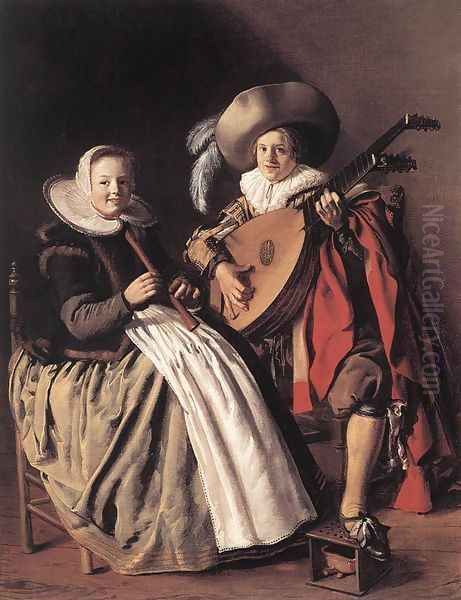
While not directly related to Molenaer's artistic circle beyond being a contemporary female artist, Magdalena van de Passe (1600-1638) was a notable engraver from Utrecht, daughter of the engraver and publisher Crispijn van de Passe the Elder. She specialized in detailed engravings, often of mythological or allegorical subjects, and is known to have taught the learned Anna Maria van Schurman. Clarifying her identity is important to avoid confusion with Molenaer's actual wife, Judith Leyster.
Later Life, Financial Issues, and Legacy
Jan Miense Molenaer and Judith Leyster moved between Haarlem, Amsterdam, and eventually settled in Heemstede, near Haarlem. Despite a seemingly productive career, archival records suggest Molenaer faced financial difficulties later in life. His estate inventory, drawn up after his death, reveals numerous debts and ongoing disputes with creditors. The subsequent auction of his assets led to protracted legal battles over the inheritance that reportedly lasted for centuries, painting a picture of a complex financial situation despite his artistic output.
Molenaer died in Haarlem in 1668 and was buried there. For a long period after his death, his reputation, like that of many Dutch minor masters, faded somewhat. However, renewed scholarly interest in the Dutch Golden Age during the late 19th and 20th centuries led to a reassessment of his work. He came to be recognized as a key figure in the development of Dutch genre painting, particularly associated with the Haarlem school.
Today, Jan Miense Molenaer is appreciated for his lively and diverse portrayals of 17th-century Dutch life. His paintings are valued for their observational detail, their frequent humor, their engagement with musical themes, and the insight they offer into the social fabric of the era. He is seen as an important link between the robust style of Frans Hals and the more narrative and detailed genre scenes of artists like Jan Steen. His works are held in major museums worldwide, ensuring his contribution to the Dutch Golden Age remains visible and studied.
Conclusion
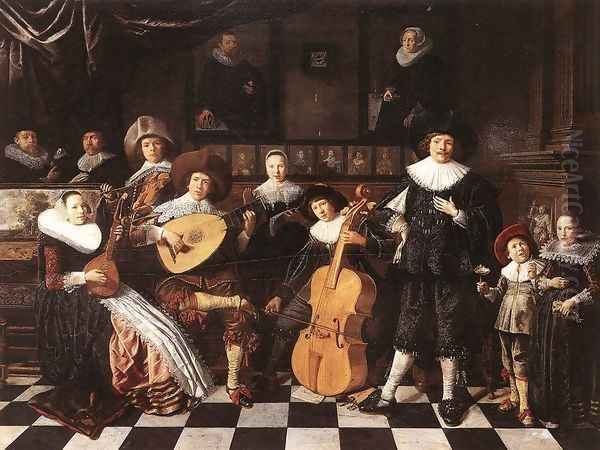
Jan Miense Molenaer was a prolific and engaging painter whose work captures the spirit of the Dutch Golden Age. From his early, Hals-influenced scenes of boisterous peasants to his later, more refined depictions of domestic life, music, and children's games, he consistently provided a vibrant and often humorous commentary on the world around him. His partnership with Judith Leyster adds another layer of interest to his biography. Though perhaps overshadowed at times by bigger names like Rembrandt or Vermeer, Molenaer's keen eye for detail, his evolving style, and his dedication to chronicling the everyday activities of his contemporaries secure his place as a significant master of Dutch genre painting. His canvases continue to delight and inform, offering a valuable and accessible window onto life in the 17th-century Netherlands.